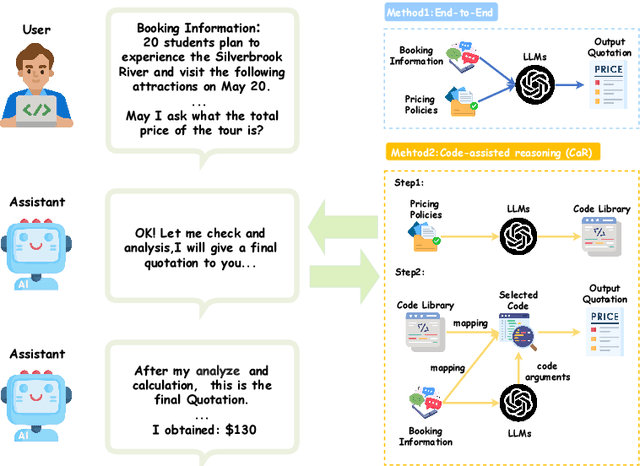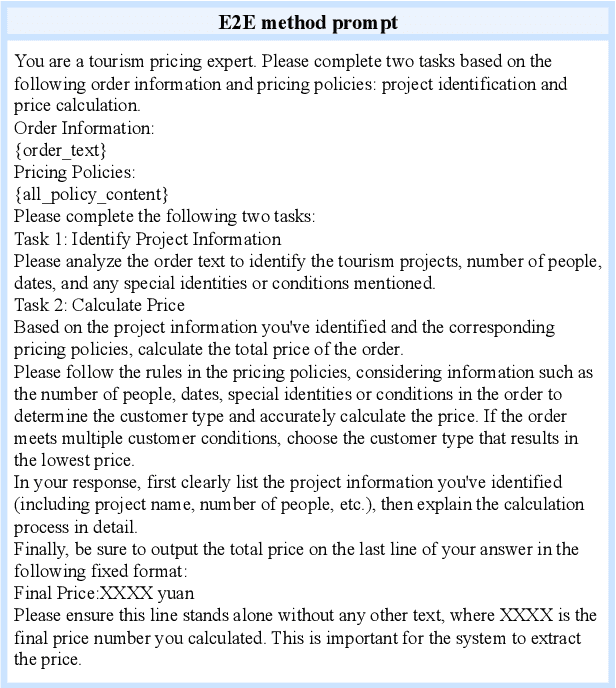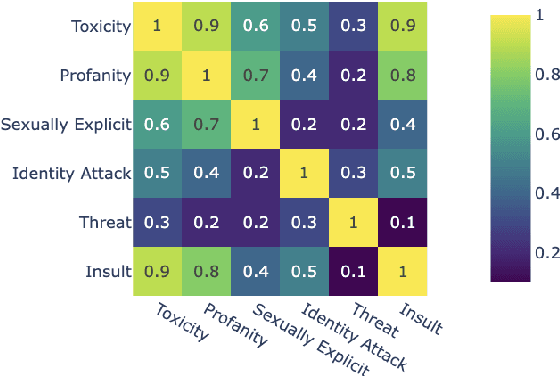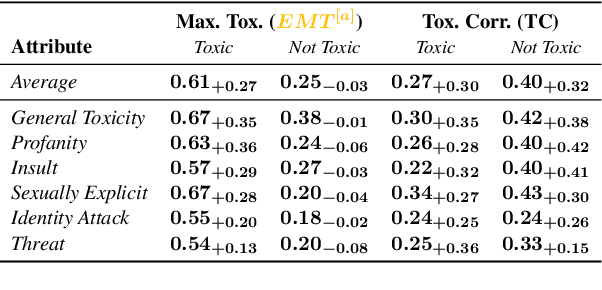Dietrich Klakow
PricingLogic: Evaluating LLMs Reasoning on Complex Tourism Pricing Tasks
Oct 14, 2025



Abstract:We present PricingLogic, the first benchmark that probes whether Large Language Models(LLMs) can reliably automate tourism-related prices when multiple, overlapping fare rules apply. Travel agencies are eager to offload this error-prone task onto AI systems; however, deploying LLMs without verified reliability could result in significant financial losses and erode customer trust. PricingLogic comprises 300 natural-language questions based on booking requests derived from 42 real-world pricing policies, spanning two levels of difficulty: (i) basic customer-type pricing and (ii)bundled-tour calculations involving interacting discounts. Evaluations of a line of LLMs reveal a steep performance drop on the harder tier,exposing systematic failures in rule interpretation and arithmetic reasoning.These results highlight that, despite their general capabilities, today's LLMs remain unreliable in revenue-critical applications without further safeguards or domain adaptation. Our code and dataset are available at https://github.com/EIT-NLP/PricingLogic.
Accept or Deny? Evaluating LLM Fairness and Performance in Loan Approval across Table-to-Text Serialization Approaches
Aug 29, 2025



Abstract:Large Language Models (LLMs) are increasingly employed in high-stakes decision-making tasks, such as loan approvals. While their applications expand across domains, LLMs struggle to process tabular data, ensuring fairness and delivering reliable predictions. In this work, we assess the performance and fairness of LLMs on serialized loan approval datasets from three geographically distinct regions: Ghana, Germany, and the United States. Our evaluation focuses on the model's zero-shot and in-context learning (ICL) capabilities. Our results reveal that the choice of serialization (Serialization refers to the process of converting tabular data into text formats suitable for processing by LLMs.) format significantly affects both performance and fairness in LLMs, with certain formats such as GReat and LIFT yielding higher F1 scores but exacerbating fairness disparities. Notably, while ICL improved model performance by 4.9-59.6% relative to zero-shot baselines, its effect on fairness varied considerably across datasets. Our work underscores the importance of effective tabular data representation methods and fairness-aware models to improve the reliability of LLMs in financial decision-making.
Voice Conversion Improves Cross-Domain Robustness for Spoken Arabic Dialect Identification
May 30, 2025Abstract:Arabic dialect identification (ADI) systems are essential for large-scale data collection pipelines that enable the development of inclusive speech technologies for Arabic language varieties. However, the reliability of current ADI systems is limited by poor generalization to out-of-domain speech. In this paper, we present an effective approach based on voice conversion for training ADI models that achieves state-of-the-art performance and significantly improves robustness in cross-domain scenarios. Evaluated on a newly collected real-world test set spanning four different domains, our approach yields consistent improvements of up to +34.1% in accuracy across domains. Furthermore, we present an analysis of our approach and demonstrate that voice conversion helps mitigate the speaker bias in the ADI dataset. We release our robust ADI model and cross-domain evaluation dataset to support the development of inclusive speech technologies for Arabic.
Charting the Landscape of African NLP: Mapping Progress and Shaping the Road Ahead
May 28, 2025Abstract:With over 2,000 languages and potentially millions of speakers, Africa represents one of the richest linguistic regions in the world. Yet, this diversity is scarcely reflected in state-of-the-art natural language processing (NLP) systems and large language models (LLMs), which predominantly support a narrow set of high-resource languages. This exclusion not only limits the reach and utility of modern NLP technologies but also risks widening the digital divide across linguistic communities. Nevertheless, NLP research on African languages is active and growing. In recent years, there has been a surge of interest in this area, driven by several factors-including the creation of multilingual language resources, the rise of community-led initiatives, and increased support through funding programs. In this survey, we analyze 734 research papers on NLP for African languages published over the past five years, offering a comprehensive overview of recent progress across core tasks. We identify key trends shaping the field and conclude by outlining promising directions to foster more inclusive and sustainable NLP research for African languages.
Attention on Multiword Expressions: A Multilingual Study of BERT-based Models with Regard to Idiomaticity and Microsyntax
May 09, 2025Abstract:This study analyzes the attention patterns of fine-tuned encoder-only models based on the BERT architecture (BERT-based models) towards two distinct types of Multiword Expressions (MWEs): idioms and microsyntactic units (MSUs). Idioms present challenges in semantic non-compositionality, whereas MSUs demonstrate unconventional syntactic behavior that does not conform to standard grammatical categorizations. We aim to understand whether fine-tuning BERT-based models on specific tasks influences their attention to MWEs, and how this attention differs between semantic and syntactic tasks. We examine attention scores to MWEs in both pre-trained and fine-tuned BERT-based models. We utilize monolingual models and datasets in six Indo-European languages - English, German, Dutch, Polish, Russian, and Ukrainian. Our results show that fine-tuning significantly influences how models allocate attention to MWEs. Specifically, models fine-tuned on semantic tasks tend to distribute attention to idiomatic expressions more evenly across layers. Models fine-tuned on syntactic tasks show an increase in attention to MSUs in the lower layers, corresponding with syntactic processing requirements.
* 10 pages, 3 figures. Findings 2025
Colombian Waitresses y Jueces canadienses: Gender and Country Biases in Occupation Recommendations from LLMs
May 05, 2025Abstract:One of the goals of fairness research in NLP is to measure and mitigate stereotypical biases that are propagated by NLP systems. However, such work tends to focus on single axes of bias (most often gender) and the English language. Addressing these limitations, we contribute the first study of multilingual intersecting country and gender biases, with a focus on occupation recommendations generated by large language models. We construct a benchmark of prompts in English, Spanish and German, where we systematically vary country and gender, using 25 countries and four pronoun sets. Then, we evaluate a suite of 5 Llama-based models on this benchmark, finding that LLMs encode significant gender and country biases. Notably, we find that even when models show parity for gender or country individually, intersectional occupational biases based on both country and gender persist. We also show that the prompting language significantly affects bias, and instruction-tuned models consistently demonstrate the lowest and most stable levels of bias. Our findings highlight the need for fairness researchers to use intersectional and multilingual lenses in their work.
Evaluating Grounded Reasoning by Code-Assisted Large Language Models for Mathematics
Apr 24, 2025Abstract:Assisting LLMs with code generation improved their performance on mathematical reasoning tasks. However, the evaluation of code-assisted LLMs is generally restricted to execution correctness, lacking a rigorous evaluation of their generated programs. In this work, we bridge this gap by conducting an in-depth analysis of code-assisted LLMs' generated programs in response to math reasoning tasks. Our evaluation focuses on the extent to which LLMs ground their programs to math rules, and how that affects their end performance. For this purpose, we assess the generations of five different LLMs, on two different math datasets, both manually and automatically. Our results reveal that the distribution of grounding depends on LLMs' capabilities and the difficulty of math problems. Furthermore, mathematical grounding is more effective for closed-source models, while open-source models fail to employ math rules in their solutions correctly. On MATH500, the percentage of grounded programs decreased to half, while the ungrounded generations doubled in comparison to ASDiv grade-school problems. Our work highlights the need for in-depth evaluation beyond execution accuracy metrics, toward a better understanding of code-assisted LLMs' capabilities and limits in the math domain.
Agree to Disagree? A Meta-Evaluation of LLM Misgendering
Apr 23, 2025Abstract:Numerous methods have been proposed to measure LLM misgendering, including probability-based evaluations (e.g., automatically with templatic sentences) and generation-based evaluations (e.g., with automatic heuristics or human validation). However, it has gone unexamined whether these evaluation methods have convergent validity, that is, whether their results align. Therefore, we conduct a systematic meta-evaluation of these methods across three existing datasets for LLM misgendering. We propose a method to transform each dataset to enable parallel probability- and generation-based evaluation. Then, by automatically evaluating a suite of 6 models from 3 families, we find that these methods can disagree with each other at the instance, dataset, and model levels, conflicting on 20.2% of evaluation instances. Finally, with a human evaluation of 2400 LLM generations, we show that misgendering behaviour is complex and goes far beyond pronouns, which automatic evaluations are not currently designed to capture, suggesting essential disagreement with human evaluations. Based on our findings, we provide recommendations for future evaluations of LLM misgendering. Our results are also more widely relevant, as they call into question broader methodological conventions in LLM evaluation, which often assume that different evaluation methods agree.
Implementing Rational Choice Functions with LLMs and Measuring their Alignment with User Preferences
Apr 22, 2025Abstract:As large language models (LLMs) become integral to intelligent user interfaces (IUIs), their role as decision-making agents raises critical concerns about alignment. Although extensive research has addressed issues such as factuality, bias, and toxicity, comparatively little attention has been paid to measuring alignment to preferences, i.e., the relative desirability of different alternatives, a concept used in decision making, economics, and social choice theory. However, a reliable decision-making agent makes choices that align well with user preferences. In this paper, we generalize existing methods that exploit LLMs for ranking alternative outcomes by addressing alignment with the broader and more flexible concept of user preferences, which includes both strict preferences and indifference among alternatives. To this end, we put forward design principles for using LLMs to implement rational choice functions, and provide the necessary tools to measure preference satisfaction. We demonstrate the applicability of our approach through an empirical study in a practical application of an IUI in the automotive domain.
Aligned Probing: Relating Toxic Behavior and Model Internals
Mar 17, 2025



Abstract:We introduce aligned probing, a novel interpretability framework that aligns the behavior of language models (LMs), based on their outputs, and their internal representations (internals). Using this framework, we examine over 20 OLMo, Llama, and Mistral models, bridging behavioral and internal perspectives for toxicity for the first time. Our results show that LMs strongly encode information about the toxicity level of inputs and subsequent outputs, particularly in lower layers. Focusing on how unique LMs differ offers both correlative and causal evidence that they generate less toxic output when strongly encoding information about the input toxicity. We also highlight the heterogeneity of toxicity, as model behavior and internals vary across unique attributes such as Threat. Finally, four case studies analyzing detoxification, multi-prompt evaluations, model quantization, and pre-training dynamics underline the practical impact of aligned probing with further concrete insights. Our findings contribute to a more holistic understanding of LMs, both within and beyond the context of toxicity.
 Add to Chrome
Add to Chrome Add to Firefox
Add to Firefox Add to Edge
Add to Edge